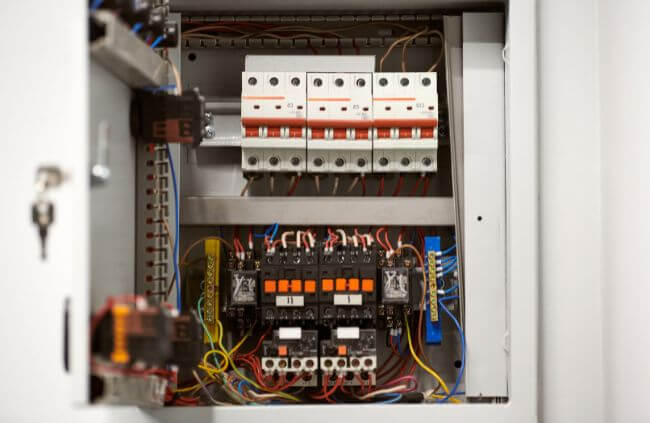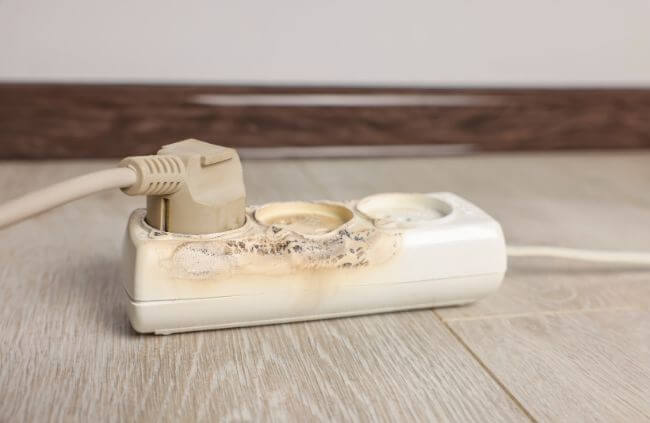If you are dealing with a circuit breaker that keeps tripping, it is not only frustrating but dangerous. It is important that you find the cause of a tripping breaker, or “breaker keep tripping” situation and have it resolved.
Leaving the issue untreated can lead to costly repairs and potential fires. At Dave Fenech Electrical Services, we are here to help you determine the problem and get it fixed safely.
What Is a Circuit Breaker?
A circuit breaker is a critical safety device in your electrical system. When the breaker detects a problem or is overloaded, it interrupts the electrical current. This, in turn, trips the breaker.
When a breaker trips, it cuts off power to protect the wiring and prevent overheating, fires, and damage to your appliances.

What Happens When a Circuit Breaker Trips?
When a circuit breaker trips, it protects your electrical circuits and home from damage. Circuit breakers are designed to stop the flow of electric current when they detect unsafe conditions.
If a short circuit occurs or a circuit overload takes place, the breaker will trip to prevent damage to electrical equipment, wires, or connected devices. While this protective action helps avoid damage, a frequently tripping circuit breaker is a definite sign that there is a problem.
A tripped circuit breaker can be reset by switching it back to the on position. However, if the breaker trips again immediately, this could indicate an underlying issue.
Tripping breaker issues often require the expertise of an electrician to diagnose and resolve.
Why Does My Circuit Breaker Keep Tripping?
There are several reasons why your circuit breaker trips. Some of these are:
Overloaded Circuit
A circuit overload is the most common reason for a breaker to keep tripping. An overload can happen when too many electrical devices are plugged into a single circuit. The devices draw more power than the system can handle. Having an overloaded circuit can be extremely dangerous.
Short Circuit
Short circuits occur when a live wire comes in contact with a neutral wire. The wires can lead to sparks, heat, and a burnt smell. When this happens, it should trip the breaker.
Ground Fault
A ground fault occurs when a live wire touches the ground or a metal frame. Ground faults are extremely dangerous and can pose a risk of electric shock. Ground faults can also lead to fires if not fixed immediately.
Faulty Appliances
Old or damaged appliances can cause a tripped circuit breaker. When an appliance has frayed cords, damaged internal wiring, or insulation issues, it can draw excessive current.
Faulty Wiring
Worn-out or improperly installed wiring is a fire hazard and another common cause of breaker trips. When insulation on wiring deteriorates or connections become loose, it can cause your breaker to trip.
Storms
Lightning storms can also lead to a tripped breaker. Storms will often trip all the breakers at once. However, sometimes only one or two circuits will trip.
The Dangers of a Tripped Circuit Breaker
If a circuit breaker keeps tripping it can be dangerous. Common risks include:
Fire Hazards
A short circuit or circuit overload can generate excessive heat, increasing the risk of electrical fires. Corroded wires and faulty electrical switches further elevate this danger.
If you notice signs of overheating, burning smells, or your circuit breaker keeps tripping, contact a qualified electrician to prevent further damage.
Damage to Appliances and Equipment
Constant interruptions in electric current can damage sensitive electrical equipment.
Electrical Shocks
Unaddressed ground wires or exposed connections can increase the risk of electrical shocks, posing a threat to your safety.
Expensive Repairs
What may seem like small issues, like a bad circuit breaker or loose wires, can escalate into large costly electrical repairs.
Signs of an Overloaded Circuit
An overloaded circuit is one of the most common reasons for a tripped circuit breaker. Signs of an overloaded circuit include flickering lights, buzzing outlets, or warm switch plates. These occur when the circuit is handling more electrical power it can handle.
If you plug multiple devices into the same circuit, your breaker may trip. Avoid using too many appliances on a single electrical circuit. Instead, consider having dedicated circuits installed for high-demand equipment.
How Do I Find Out What’s Tripping My Breaker?
Before resetting the breaker, you should try to identify why the circuit breaker trips. Here are some things you can do to find the cause.
Turn Off and Unplug Devices
Switch off and unplug all devices connected to the tripped electrical circuit. This can help you determine if an overloaded circuit was the cause.
Inspect for Visible Damage
Inspect the cords, plugs, and outlets for signs of damage. This could be burning, melting, or an unusual smell. If you spot damage to the cords, replace the items or repair electrical cords.
Reset the Breaker
Once you have turned off all connected devices and inspected the cords, reset the breaker. If it trips again immediately, it is likely due to a short circuit, ground fault, or wiring issue.
Check Outlets and Switches
Sometimes, worn-out outlets or switches can cause a breaker to keep tripping.
Call a Professional
If the breaker continues to trip after you have tried troubleshooting on your own, give Dave Fenech Electrical Services a call.

What to Do When Your Circuit Breaker Keeps Tripping
If your breaker keeps tripping, you may be able to take corrective steps yourself. However, some issues require the expertise of a professional.
Replace the Circuit Breaker
If your circuit breaker keeps tripping, it might be a sign that it is worn out. Our licensed electricians can assess your breaker and determine if a replacement is needed.
Install GFCI Outlets
GFCI outlets help prevent shocks and reduce circuit trips. They work by detecting problems and shutting off power immediately. Installing these outlets in high moisture areas like kitchens and bathrooms adds an extra level of safety.
Upgrade Your Electrical Panel
A lot of older homes in Sydney are not equipped to handle the energy demands of today’s appliances and electronics. If your electrical panel is outdated, it might be unable to handle your power needs.
When to Replace Electrical Equipment
Old or faulty electrical equipment can cause a tripped breaker. Appliances with damaged cords or internal wiring issues can draw irregular currents, leading to circuit breaker tripping.
Replacing defective electrical equipment not only prevents breaker tripping, but also reduces the risk of fires. A professional electrician can help assess whether your appliances or wiring need updates to keep your home and family safe.
Recognising the Signs of a Bad Circuit Breaker
Sometimes, the issue lies not with your appliances or electrical circuits, but with the breaker itself. If you have a faulty circuit breaker you may exhibit the following signs.
- Inconsistent Tripping – If your circuit breaker trips at random times or when not overloaded, it may be defective.
- Physical Damage – A breaker that shows signs of wear, like scorch marks or a burnt smell, is a potential fire hazard. You should have the breaker panel replaced immediately.
- Fails to Stay On – If the circuit breaker has tripped and will not stay on, it is time to call in a professional.
Should I Replace a Breaker that Keeps Tripping?
Circuit breakers are designed to protect your home by shutting off power when they experience an issue. However, over time, breakers can wear out, becoming less reliable and tripping unnecessarily.
Replacing a bad circuit breaker is essential for the safety of your electrical system. A qualified electrician can inspect the breaker and determine if it is the problem or if here is another issue. Other issues that can cause the circuit breaker to trip are loose wires, damaged wires, overloaded circuits, or a faulty electrical switch.
Ignoring a breaker that frequently trips could lead to issues such as an electrical fire, electrical shocks, and damaged electrical devices.
If you continue tripping the circuit breaker, have it inspected by a professional. They are able to determine whether replacement is necessary.
How to Prevent Tripping Circuit Breakers
Taking proactive measures can reduce the likelihood of tripping circuit breakers in your home:
Distribute the Electrical Load
Avoid overloaded circuits by redistributing appliances across different circuits. For example, do not run a microwave, toaster, and kettle on the same circuit. This prevents circuit overloads and reduces stress on your electrical circuits.
Install Dedicated Circuits
Heavy-duty appliances like refrigerators, air conditioners, and washing machines should operate on dedicated circuits. This will help to prevent them from overloading the switch box. A qualified electrician can add these circuits to your system.
Inspect and Replace Damaged Wiring
Loose or corroded wires and aging electrical cords are major causes of a frequently tripping circuit breaker. Schedule regular inspections with a licensed electrician to identify and address these issues before they lead to electrical fires.
Upgrade the Electrical Panel
Older homes may have panels that cannot handle modern electrical power demands. Upgrading your panel increases capacity and reduces the likelihood of a tripped circuit breaker.
Use GFCI Outlets
Install Ground Fault Circuit Interrupter (GFCI) outlets in kitchens, bathrooms, and other moisture-prone areas. GFCIs are designed to shut off power to prevent electrical shocks.
Replace Faulty Circuit Breakers
A bad circuit breaker can cause intermittent or frequent tripping. If you suspect your breaker is faulty, have it inspected and replaced by a professional. We can inspect your electrical system and make certain the circuit breaker works properly.

Why Regular Switch Box Maintenance Matters
Your home’s switch box is the heart of its electrical system. Dust buildup, aging components, or loose connections can cause a breaker to trip unexpectedly. Routine servicing by a professional can extend the lifespan of your system and prevent frequent short circuits and tripping.
Why You Need a Qualified Electrician
While some troubleshooting can be handled by homeowners, persistent problems require professional help. Here is why calling a qualified electrician is essential:
- Accurate Diagnosis – Our electricians have the expertise to identify hidden issues, such as loose connections, short circuits, or a faulty electrical switch.
- Safe Repairs – Working with electricity is dangerous. A professional can ensure all repairs are safely made.
- Preventative Measures – Electricians can upgrade your system, install dedicated circuits, and replace old components.
At Dave Fenech Electrical Services, we specialize in diagnosing and repairing electrical systems throughout Sydney. Whether your circuit breaker has tripped or you have a damaged ground wire, our team is here to help.
Breaker Keep Tripping? Call Us Today
Does your breaker keep tripping? If so, it is time to contact a licensed electrician. A professional can perform a thorough inspection and identify the issue and resolve it safely.
At Dave Fenech Electrical Services, we understand how inconvenient and stressful a tripping breaker can be. Do not let a breaker keep tripping, call us instead for expert home electrical repairs throughout Sydney.

